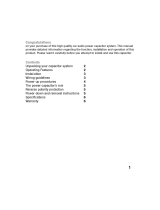
fine screen would keep rocks from falling over),
which would prolong the flow of water but not stop it
completely. Like rocks are for water, resistors work in
a
similar way. They regulate how much electric
current flows. The resistance, is expressed in ohms
(W, named in honor of George Ohm), kilohms (kW,
1,000 ohms) or megohms (MW, 1,000,000 ohms) is
a determination of how much resistor resists the flow
of electricity. The water through a pipe can be
increased by an increase in water pressure or the
removal of rocks. In a similar way you can increase
the electric current in a circuit by increasing the
voltage or by the use of a lower value resistor (this
will be shown in a moment). Below the symbol for the
resistor is shown.
Resistor Color Code: The method for marking the
value of resistance on a part is by using colored
bands on each resistor. The representation of the
first ring is the digit of the value of the resistor. The
second ring is a representation of the second digit of
the resistors value. The third ring means that you to
which power of ten to multiply by, ( or the amount of
zeros to add). The fourth and final ring is a
representation of the construction tolerance. A
majority of resistors have a gold band that
represents 5% tolerance. Simply this means that the
resistor value is guaranteed to be 5% of the valued
marked. See the color chart on page 159.
Variable Resistor (Control): The variable resistor
is simply a control and this is required in many
electric circuits. The variable resistor can be used as
a light dimmer, volume control, and in many other
circuits when you are wanting to change resistance
easily and quickly. A normal resistor is shown, this
contains an additional arm contact that moves along
the resistive material and can tap off the resistance
desired.
Capacitors: Capacitors move alternating current
(AC) signals while prohibiting direct current (DC)
signals to pass. They store electricity and can
f
unction as filters to smooth out signals that pulsate.
Capacitors that are small are traditionally used in
high-frequency applications such as radios,
transmitters, or oscillators. Larger capacitors
ordinarily reserve electricity or act as filters. The
capacitance (capacity for storing electricity) of a
capacitor is expressed in a unit known as farad. An
extremely large amount of electricity defines the
farad. Most of the value of capacitors is
predetermined in millionths-of-a-farad or
microfarads.
Electrolytic - Electrolytic are the four largest
capacitors. They are marked with an “–”. There is
only one-way to connect them to the circuit, the +
and the – wires must always go into the correct
terminals.
Note - For safety, the electrolytic capacitors used in
the EP-130 are nonpolarized
type.
Disc - Unlike the electrolytic above, these capacitors
have no polarity and can be connected in either way.
Tuning Capacitor: Ever wonder what that knob that
changes the stations on your radio is? It’s a tuning
capacitor. When the knob is rotated, the capacitance
is changed. This alters the frequency of the circuit,
letting through only one frequency and blocking out
the rest.
-6-
Disc Electrolytic
EP-130_62315RevC.qxp_EP-130_062812 6/23/15 11:16 AM Page 6


























